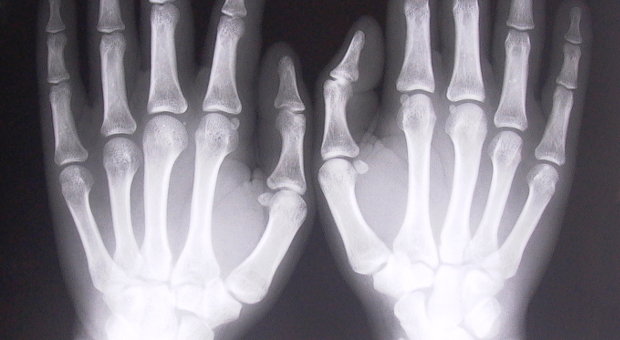Common gene variants linked to delayed healing of bone fractures

Slow-healing or non-healing bone fractures in otherwise healthy people may be caused by gene variants that are common in the population, according to Penn State College of Medicine researchers.
“We found associations between certain gene polymorphisms and delayed fracture healing in a sample of patients,” said J. Spence Reid, professor of orthopaedics and rehabilitation. “Our study was preliminary but it demonstrated the feasibility of a larger one, which we're now working to set up.”
The identification of gene variants that delay fracture healing could lead to screening tests for patients with broken bones. Those patients deemed likely to experience slow healing could be given more aggressive treatment when they first reach the hospital, potentially avoiding months of debilitation.
The researchers reported their results in the Journal of Bone and Joint Surgery.
Of the eight million bone fractures in the U.S. every year, about 10 percent fail to heal normally. Smoking, diabetes, NSAID use, low vitamin D levels and old age are known risk factors, but in a significant subset of cases, unknown factors appear to be involved.
“Some fractures are slow-healing for no obvious reason, and we wondered if there is a genetic basis for those cases,” said Reid.
He and his colleagues selected from their records 33 patients diagnosed with “atrophic nonunion” – the failure of a fracture to knit together on its own within six months. As controls, they selected 29 patients whose fractures had healed normally.
Using cheek swabs, the researchers obtained DNA from the patients. In each case they checked tiny sites of known DNA-sequence variations – “single nucleotide polymorphisms” – that mark common gene variants. They looked only at the SNPs within 30 genes suspected of involvement in fracture healing.
The analysis revealed three SNPs that were more common in the non-healing group than in the normal-healing group – hinting that their respective gene variants may somehow impair or fail to support fracture healing.
Two of these SNPs are within a single gene, which codes for the enzyme nitric oxide synthase 2 (NOS2). Prior studies showed that this enzyme is produced early in the fracture healing process, and that deletion of the NOS2 gene delays healing in mice.
The other SNP of interest lies within the gene for interleukin 1-Beta, a signaling molecule best known as a promoter of inflammation. Interleukin 1-Beta is suspected also to be an early orchestrator of the new bone growth that knits together a fracture.
The findings point to the possibility that common variants of NOS2 and interleukin 1-Beta have reduced function in support of fracture healing, and raise the risk of a delayed healing. But Reid cautioned that the small patient sample and the small number of genes analyzed means that the results should be considered preliminary until a larger study is done.
The researchers are currently planning a study with a larger patient sample and a broader mapping of the genome, to provide a more definitive picture of the gene variants associated with delayed fracture healing.
In principle, identifying specific gene variants as risk factors for poor fracture healing would lead not only to the development of patient screening tests, but also to a better understanding of the basic biology of how fractures heal.
“We could develop mouse models of these genetic polymorphisms, for example, to observe in detail the role they play after a fracture,” Reid said.
Other researchers were Vikram Sathyendra, orthopaedics resident; Henry J. Donahue, professor of orthopaedics and rehabilitation; Kent E. Vrana, professor of pharmacology; Arthur Berg, associate professor of biostatistics and bioinformatics; David Fryzel, resident in general surgery; and Jonathan Gandhi, a member of the Penn State College of Medicine class of 2013.
The Orthopaedic Trauma Association funded this study.
If you're having trouble accessing this content, or would like it in another format, please email Penn State Health Marketing & Communications.
